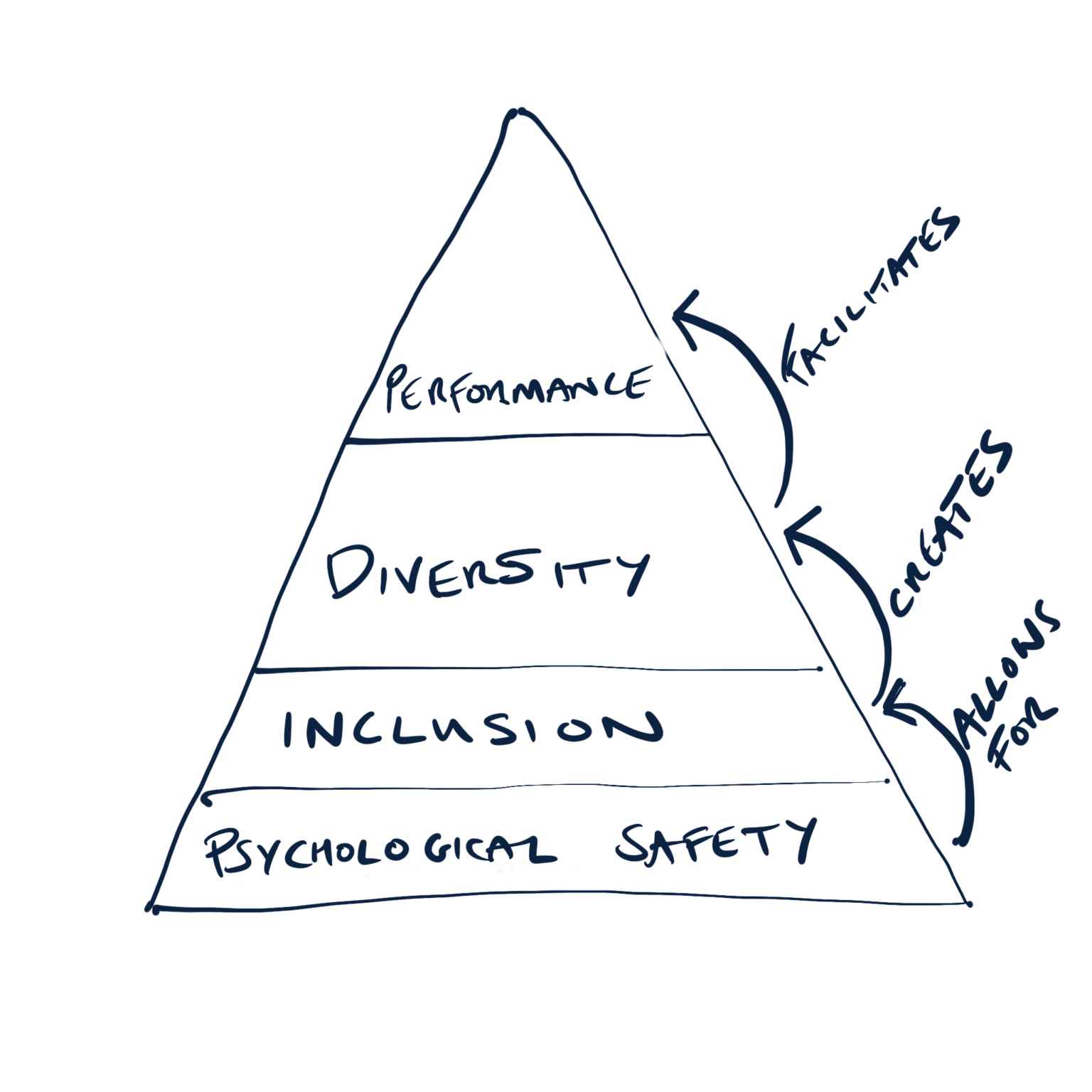How psychological safety drives high-performing teams (and fosters inclusion)
Your team needs to feel safe for innovation to flourish and performance to thrive. By creating a psychologically safe team environment, members not only speak more freely and take more necessary risks, but it can also help you better achieve your diversity, equity, and inclusion (DEI) goals.
Table of contents
Within top-performing teams, members feel psychologically safe. It’s one of the main outcomes of major internal research within Google, aimed at identifying the key drivers behind their teams. Results showed that the most important dynamic of effective teams was the existence of psychological safety.
But what is psychological safety exactly, and how can you, too, build a psychologically safe workplace for your team? You’ll find the answers below.
Stick around and you will learn:
- What is psychological safety?
- 9 reasons why you should create a psychologically safe working environment
- The importance of psychological safety for your DEI
- How to measure psychological safety in your team
- 7 strategies to foster psychological safety in your business
What is psychological safety?
Psychological safety refers to the belief that you can speak up and express yourself without having to fear negative consequences.
In a (business) team context, psychological safety has probably been best defined by Amy C. Edmondson, Novartis Professor of Leadership and Management at Harvard Business School. She explains on her website how she defines psychological safety as:
“… a belief that one will not be punished or humiliated for speaking up with ideas, questions, concerns or mistakes, and that the team is safe for interpersonal risk-taking. Think of it as felt permission for candor.”
Let’s further explain this with an example:
Imagine your team consists of you, two colleagues, and your manager. In the past, you’ve brought some daring ideas to the table during brainstorming sessions. Your manager repeatedly downplayed your suggestions, saying they were “too out there”, while one of your colleagues said they’re downright dumb.
During today’s brainstorming session, you decide to keep your ideas to yourself. The others won’t appreciate them anyway, and you rather save yourself from the embarrassment and public shame. One week later, you notice your company’s main competitor had the same idea and it’s an absolute hit. If only you would’ve brought it up…
The whole reason why you didn’t bring your idea to the table was that your team was missing one key ingredient: Psychological safety.
If you had felt like you wouldn’t be punished, humiliated, or ridiculed for your idea, you would have brought it up. You would have been okay with taking risks and throwing out a daring and potentially unsuccessful idea for the chance that it would actually be a great one.
But instead, you held your tongue and, as a result, you and your team missed out on an amazing opportunity. And this is but one example of how psychological safety can benefit you and your team.
9 reasons why you should create a psychologically safe working environment
In 2012, Google embarked on an ambitious project to determine what made the perfect team. They called it Project Aristotle, paying tribute to Aristotle’s famous quote stating that “the whole is greater than the sum of its parts”. After all, a cohesive team of five functions better than the same amount of lone rangers doing their own thing in isolation.
After analysis, Google’s researchers found that the main characteristic of successful teams was that of psychological safety. When team members felt safe to take risks and be vulnerable in front of each other, the team thrived better than ever.
As Patrick Lencioni, author of the best-selling business book The Five Dysfunctions of a Team, explains: “Remember teamwork begins by building trust. And the only way to do that is to overcome our need for invulnerability”.
But why, exactly, should we force ourselves to embrace vulnerability? Here are 9 reasons why you should create a psychologically safe working environment.
1. Increases employee engagement
If team members feel safe and empowered to share their thoughts, they will be more inclined to do so. This leads to a much more engaged team of individuals who aren’t afraid to speak their minds.
Not only will the outcome be more creativity and innovation (see point 2), but it will benefit team bonding (and building) as well. Without fear of saying the wrong thing, team members will be more open and transparent, both on a professional and a personal level.
The result? A more tightly-knit team and much higher employee engagement.
2. Fosters creativity, ideation, and innovation
Within psychologically safe spaces, there are no “stupid” questions or suggestions. Every opinion and idea matters and deserves to be welcomed with an equal level of empathy and fair consideration.
By knowing that your remarks won’t be met with negativity or instant dismissal, you are more likely to say whatever is on your mind, even when you’re not certain whether it’s a good idea or not. This allows for brainstorming more freely, which can sometimes lead to the smartest, most creative, and most innovative ideas.
3. Unlocks the benefits of diversity in teams
Psychological safety is a crucial ingredient when managing diverse teams, and it can even actively promote diversity within your team.
We will dive deeper into the connection between psychological safety and Diversity, Equity, and Inclusion (DEI) further below.
4. Improves how team members learn from mistakes
The premise of psychological safety is that team members shouldn’t be afraid to make mistakes. After all, mistakes are only human and (practically) unavoidable. What’s important is that team members are given the opportunity to make these mistakes and learn from them, rather than facing negative consequences.
And this openness to mistakes doesn’t just lead to more risk-taking and coming up with daring solutions, as seen in point 2. Once mistakes are made, team members are empowered to own up to their mistakes and discuss their learnings much more freely.
5. Facilitates a strong feedback culture
This openness to failure and the ability to speak freely further help foster a strong feedback culture in the workplace, as employees will be more candid in giving feedback and more open to receiving feedback.
An extra benefit is that this, in turn, helps foster what Carol Dweck, a psychology professor at Stanford University, refers to as a growth mindset. This is a way of thinking in which the individual is not only open to failure but sees it as an exciting opportunity for growth, which leads to accelerated innovation.
Within psychologically safe environments, such a mindset is not just supported, but actively promoted.
6. Supports mental health
Pressure to not make mistakes and the fear of repercussions when failure does happen can be serious causes of stress and anxiety. After all, constantly being on your toes and carefully considering everything you say and do can be emotionally draining.
This type of pressure building up can be the cause of burnout. Creating a psychologically safe space can help alleviate this burden on an employee’s mental health.
7. Improves employee retention
Did you know that research has found that the number one skill employees feel their manager lacks is communication? It shows that communication really is key. Within a psychologically safe team, both you and your employees will communicate more effectively than before.
And even if your communication skills as a manager are somewhat lacking, your team members will be candid enough to point it out to you. This means you will grow as a manager as well.
Now consider that the same research found that only 27% of employees with good managers consider leaving their company, compared to 63% of employees with bad managers, and you see how psychological safety can benefit employee retention.
And with the Great Resignation still on the way and the struggles of getting employees back to the office, retaining your top talent is more important than ever.
8. Boosts employer branding and talent attraction
Not only will it help retain existing employees, but it can help attract new talent and boost your employer branding.
Explaining in your job ads—or on your career page—how you invest in creating psychologically safe teams can be a great draw for talented individuals. Knowing that they can be themselves and make mistakes without fear of repercussion can be a big selling point for your business.
Psychological safety is a company benefit that’s free of charge and benefits employees and employers alike.
Attract talent faster—for free!
Find out how JOIN can help you better reach and attract the right candidates
Learn more9. Creates brand ambassadors
All the points above ultimately make your company a great place to work for your employees. And if your employees are happy working at your company, they will be more than happy to brag about it to their network.
They might simply tell their friends and family about your awesome company, or perhaps they’ll share it publicly on LinkedIn. As they become brand ambassadors, they will also be more likely to refer your company to potential new employees.
The importance of psychological safety for your DEI
As shortly mentioned, psychological safety is also essential in effectively managing diverse teams. And this is where this concept can arguably bring the most value to your business.
Diversity beyond recruiting
Companies are increasingly recognising and leveraging the benefits of building diverse teams. By implementing diversity recruiting strategies to prevent unconscious bias in recruiting and by hiring for culture add rather than cultural fit, managers are trying to build more diverse and inclusive teams.
And there are many arguments for this diversity in recruiting. First and foremost, it’s the morally correct thing to do. But a vast amount of studies conducted by industry giants like McKinsey, Glassdoor, and Harvard Business Review all reach the same key conclusions:
- Diverse teams outperform homogeneous teams
- Employees want to work in diverse companies
But it’s important to note here that a truly effective DEI strategy doesn’t end the moment your new employee is hired. Instead, you need to ensure you create a company culture and workplace environment that allows everyone to thrive, regardless of their background. And this is where psychological safety comes into play.
Psychological safety and DEI
We spoke with Tom Geraghty, founder of psychological safety training provider PsychSafety and host of the weekly Psychological Safety Newsletter, about the connection between psychological safety and DEI.
Geraghty explains: “You can’t ‘do’ inclusion without fostering psychological safety. People cannot feel included if they do not feel safe, and without a culture of inclusion, you won’t be able to engender diversity.”
He created this visual representation of how psychological safety is at the basis of inclusion, diversity, and, ultimately, better performance in teams:

In other words, you can hire a diverse workforce, but if your team isn’t empowered to share their thoughts and ideas freely your efforts are likely to fall flat.
As Geraghty further explains, “psychological safety is a necessary component of diversity ‘that sticks’: We can recruit a diverse workforce, but they’re not going to stay unless there’s a psychologically safe, inclusive culture”.
And chances are that even if your diverse team sticks you won’t reap the full benefits. That’s because if your organisation doesn’t provide a level playing field for all, inequalities are likely to resurface.
Consider the following:
A McKinsey study found that 18 percent fewer women feel comfortable sharing opinions or ideas that challenge the status quo in their organisation (75 percent of women vs 93 percent of men).
In other words, your team might be diverse, but this doesn’t necessarily imply that everyone will feel equally comfortable sharing their ideas and candid opinion.
That’s why psychological safety is so important in building truly thriving, diverse, and inclusive teams where every individual can participate equally.
How to measure psychological safety in your team
Now, building an environment where team members feel truly safe doesn’t happen overnight. It’s an ongoing process that needs to be actively nurtured and promoted. Below, we’ll outline the 7 key strategies to help you create a psychologically safe workplace. But first, you need to know what you need to assess and measure.
There are multiple ways to measure the level of psychological safety within a team. For example, you could consider investing in a professional self-assessment tool, like the Fearless Organization Scan.
However, the most common (and free) way was proposed by Amy Edmondson herself. She asked team members to indicate how strongly they agree or disagree with the following seven statements:
- If you make a mistake on this team, it is often held against you.
- Members of this team are able to bring up problems and tough issues.
- People on this team sometimes reject others for being different.
- It is safe to take a risk on this team.
- It is difficult to ask other members of this team for help.
- No one on this team would deliberately act in a way that undermines your efforts.
- Working with members of this team, your unique skills and talents are valued and utilised.
To start measuring, you could, for example, send these questions out to your team via a pulse survey and repeat this on a monthly or quarterly basis. The exact frequency and even the exact statements you send out may vary, but it’s important to do it consistently.
A note on accuracy
Bear in mind that although surveys are a powerful tool, they do have its shortcomings. Most notably, you always need to factor in the possibility of skewed results due to:
- Sampling bias: Team members who don’t feel psychologically safe might distrust the anonymity of the survey and not fill it in or provide false answers.
- Campbell’s Law: If team members think results may influence decision-making, they might intentionally provide false answers to skew results towards the desired outcome for the desired decision to be made.
7 strategies to foster psychological safety in your business
Now you know how to measure your efforts, let’s look at some ways in which you and your team members can foster psychological safety in your organisation.
1. Communicate your goals
You want to create a psychologically safe environment? Then start by communicating this to the team:
- Explain the concept and the reason it is important (e.g. by holding an introductory workshop)
- Set goals and share how you will measure progress (transparency is key)
- Communicate this philosophy throughout your organisation by embedding it into the core of your culture. Make psychological safety a part of your company’s DNA.
- Own up to your commitment and hold yourself as a leader accountable for its success.
And remember, fostering psychological safety is an ongoing organisational effort. Meaning, rather than solely practising a top-down approach, everyone in your organisation should actively support and promote the creation of a psychologically safe work environment.
2. Lead by example
Although it should be a company-wide effort, it’s generally up to leadership to initiate the change. And this is where many companies struggle.
In fact, Geraghty highlighted this as the most challenging aspect when building psychologically safe teams:
“As a leader, admitting your own fallibility, mistakes, and asking for help. If we can’t do that ourselves, how can we expect our team members to do the same? As leaders in privileged positions, we must model the psychologically safe behaviours for others”.
So to succeed in creating a psychologically safe environment, ensure you lead by example by:
- Owning up to your mistakes
- Being transparent about them
- Showing how you will use this opportunity to improve
Further, show your commitment by regularly asking for upward feedback and evaluate your management style to identify how you could do better as a great, empathetic leader.
3. Practice active listening
Part of effective, open communication is that you and your team members practise active listening.
Instead of merely focusing on how you might respond to something that someone has said, try to focus on what is actually being said. Place yourself in their position and try to understand it from their point of view.
For more information on how to practice active listening, check out our active listening glossary page.
4. Be respectful
Building further on the previous point, team members should always strive to be respectful toward others and their opinions.
Some points to bear in mind:
- Avoid placing blame
- Validate someone’s comments
- Thank them for their candour and for sharing their opinion
- Think about your body language and try to keep it open and respectful (e.g. do make eye contact, don’t scowl)
- Accept that sometimes you may have to agree to disagree
Also see our article on how to receive feedback.
5. Embrace the power of feedback
Feedback should be an integral part of your company’s communication. The more people across the organisation give each other feedback, the more open communication becomes, and the safer people will feel expressing their opinion.
Need help framing your feedback? Then check out our article on 10 powerful feedback models.
6. Be inclusive
Be inclusive and encourage everyone to speak up (and speak freely). As we’ve seen, some people are simply less likely to speak up, and this could be due to a variety of factors.
For example, women might feel less empowered to speak up in the workplace due to gender inequalities, while introverted people and individuals with similar personality types may tend to shy away from directly expressing their opinion.
To help encourage everyone to speak up, consider:
- Asking for regular feedback
- Directly asking people’s opinions during meetings
- Keep asking questions
- Acknowledge everyone’s input
- Be inclusive in the decision-making process
- Offer workplace coaching and mentoring to further empower your employees
7. Make everything an experiment
This last point was suggested by Geraghty when we asked him about the best advice he could give a (beginner) manager who wants to build a psychologically safe team environment. His response:
“Make everything an experiment. The outcome of the work that the team does shouldn’t just be the thing they did—more importantly, it’s the learning that we gained from it so we can do it even better next time. By making everything an experiment, we’re taking failure off the table.”
Psychological safety is all about embracing failure and mistakes so we can learn from them: “the only way we fail, is if we fail to learn”.
Creating a better workplace
Psychological safety comes down to upholding one of the most basic human rights—the freedom of opinion and expression without discrimination—within the workplace environment. It’s about creating a safe space for every individual to express their opinions, share their ideas, and ultimately thrive together as an organisation because of it.
Interested in learning more about how to improve the way you and your team work together?
Then check out our article on organisational structures—the lateral approach.
Frans Lelivelt
Frans is JOIN's multilingual Senior Content Manager. His main topic of interest in the recruitment space is DEI and how companies can reduce their (unconscious) biases to make the world of work a fairer, kinder place for everyone. Outside of work, he tries to do the same for animals, spending much of his spare time in the kitchen preparing plant-based feasts.


